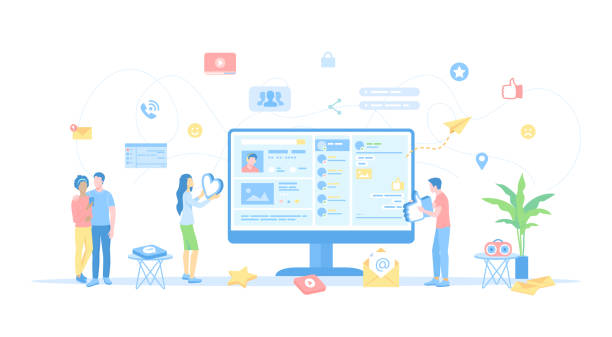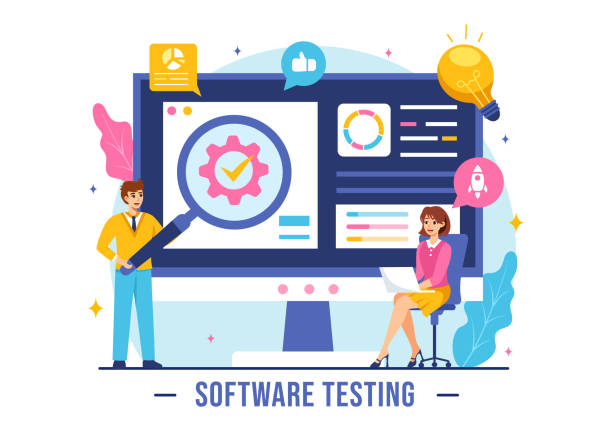Introduction to the Importance of Secure Website Design in Today’s Digital World

In today’s fast-paced world, where a large part of our daily activities has shifted to the online space, #cybersecurity and #secure_website_design have become one of the most important concerns for individuals and businesses.
With the increasing number of cyberattacks and the complexity of infiltration methods, merely having a functional website is no longer enough; the website must be resilient against various threats.
The importance of secure website design is not limited to protecting sensitive user information but also includes preserving business reputation, preventing financial losses due to service downtime, and complying with data protection regulations.
Without #strong_security, even the best user interface designs and attractive content cannot attract and retain user trust.
This is a specialized topic that requires comprehensive knowledge and approach.
The concept of web security goes beyond installing an SSL certificate and includes all layers of a website, from coding to server infrastructure.
This section explains the fundamental importance of website security in the current era and answers basic questions about why it is necessary to invest in it.
Websites are not only virtual storefronts for businesses but also places for exchanging sensitive information, conducting financial transactions, and communicating with customers.
Therefore, any security breach can have irreversible consequences for organizations and users.
Ensuring that your website is a secure digital haven for users is the cornerstone of your online success.
The correct approach to #web_security should begin from the very first stages of design and continue throughout the website’s lifecycle.
Understanding this will help you plan better for your website’s development.
Are you dissatisfied with the low sales of your online store?
Rasaweb is your solution for a professional and high-selling online store.
✅ Significant increase in sales and revenue
✅ Easy and enjoyable shopping experience for customers
⚡ Get a free consultation from Rasaweb now!
Identifying and Countering Common Web Security Threats

To achieve secure website design, one must first be familiar with common types of threats.
#cyber_attacks are becoming more complex every day, and understanding them is the first step in defense.
Among the most common threats are SQL injection attacks, Cross-Site Scripting (XSS), Cross-Site Request Forgery (CSRF), Distributed Denial of Service (DDoS) attacks, and phishing attacks.
Each of these attacks has its own specific methods and objectives and requires different countermeasures.
For example, in SQL injection attacks, an attacker attempts to access or modify database data by injecting malicious SQL code into website inputs.
Countering it requires using #validated_inputs and #using_Prepared_Statements.
XSS attacks also steal or modify user information by injecting malicious JavaScript code into users’ browsers, which can be countered with #output_validation and #Content_Security_Policy (CSP).
This section provides #specialized and #educational information on these threats and their modus operandi, offering practical solutions for #website_protection against each.
Understanding the mechanisms of these attacks is a vital step in implementing a powerful defense system.
Continuous training of the development team on the latest attack methods is also crucial.
Furthermore, following #security_news and continuously updating knowledge in this area can significantly help prevent potential damages.
A truly secure website is one that is constantly checking for new vulnerabilities and upgrading its defense systems.
This proactive approach is the foundation of any secure and reliable website design.
Secure Coding Principles and Vulnerability Prevention

One of the most fundamental pillars of secure website design is adhering to #secure_coding principles.
Most vulnerabilities arise from programming errors.
This section, in a #guidance and #specialized manner, explains techniques and best coding practices to reduce security risks.
Focusing on #input_validation, #secure_outputs, #proper_error_handling, and #using_secure_libraries are among the things every developer should pay attention to.
For example, user input should never be trusted; all input data must be #sanitized and #validated before use to prevent attacks such as SQL injection or XSS.
Also, encrypting sensitive information and using strong hash functions to store user passwords are of high importance.
| Principle | Explanation | Related Vulnerability Example |
|---|---|---|
| Input Validation | All user inputs must be checked and sanitized before processing. | SQL Injection, XSS |
| Secure Output | Ensuring that data displayed to the user does not contain malicious code. | XSS |
| Error Handling | Prevent displaying sensitive information in error messages. | Information Disclosure |
| Session Management | Session cookies and tokens should be properly managed and secured. | Session Hijacking |
Using web development frameworks that inherently include security mechanisms (such as Laravel, Django, Ruby on Rails) can significantly contribute to building an attack-resilient website.
Furthermore, implementing security policies like Content Security Policy (CSP) to prevent XSS attacks and configuring secure HTTP headers are integral parts of a #secure_web_architecture.
Developers must continuously educate themselves on best practices and the latest vulnerabilities to be effective in the secure website design process.
This is an ongoing process that begins with every line of code and continues with every update.
The Role of SSL/TLS Certificates in Creating Secure Communications

One of the most important and well-known aspects of secure website design is the use of #SSL/TLS certificates.
These certificates form the backbone of #web_communications_security, ensuring that data exchanged between the user’s browser and the web server is #encrypted and safe from unauthorized access.
When a website uses HTTPS (the secure version of HTTP), an encrypted connection is established between the user and the server, preventing eavesdropping, tampering, or forging of information.
This section #explains and provides #specialized details on the operation of SSL/TLS certificates, their types (such as DV, OV, EV), and the importance of each in guaranteeing communication security.
Correct SSL/TLS installation and configuration is not just a technical measure but a fundamental step in #user_trust_building; as the green lock icon in the browser’s address bar assures users that the website is trustworthy and their information is secure.
TLS is the more secure successor to SSL, and today all new certificates use the TLS protocol, although the term SSL is still commonly used to refer to it.
Using HTTPS is not only essential for security but also a significant factor in #SEO_ranking by search engines like Google.
A website without HTTPS not only puts user information at risk but may also rank lower in search results.
This is a vital aspect in building a secure and reliable website that should not be overlooked and is an inseparable part of any #secure_website_design strategy.
Attention to implementation details and keeping certificates up-to-date is crucial for maintaining the highest level of security.
Did you know that 85% of customers check your company’s website before any interaction?
With Rasaweb, build a corporate website worthy of your credibility.
✅ Increase credibility and customer trust
✅ Attract quality leads
⚡ Get a free website design consultation!
Securing the Database: The Backbone of Every Website

The database is the heart of every website, containing the most valuable information, including user data, transaction records, and core site content.
Therefore, #database_security is a critical component in the secure website design process.
Without adequate protection, the database can become the primary target of cyberattacks, leading to data disclosure, data corruption, or even complete website downtime.
This section provides #educational and #guidance on various aspects of database security.
Measures such as #data_encryption at rest and in transit, #precise_access_management for users to the database (e.g., the principle of least privilege), #secure_database_server_configuration, and #regular_database_software_updates are among the key actions.
Also, the use of Database Firewalls and Intrusion Detection Systems (IDS) can provide additional layers of security.
#regular_backups of data and storing them in secure locations are essential for #disaster_recovery.
A comprehensive approach to database security includes #periodic_query_review to prevent SQL injection attacks and using monitoring tools to identify suspicious activities.
#analytical_news about recent security breaches shows that many of them resulted from weaknesses in database security.
Therefore, any investment in database security is an investment in the longevity and credibility of your business.
Secure website design would be incomplete without special attention to protecting vital data in the database.
This proactive and continuous approach to data security makes your website resilient against impending threats and protects user information.
Ensure that your development team is well-versed in these concepts.
Server and Infrastructure Security: The Foundation of Secure Website Design

When it comes to secure website design, one cannot overlook #server_security and #infrastructure.
Your website’s hosting server is where all data and programming codes reside, and any weakness in its security can jeopardize the entire system.
This section provides #specialized #guidance on the most important aspects of #physical_security and #logical security of servers and network infrastructure.
Measures such as #secure_operating_system_configuration, #firewall_management, #open_ports and #unnecessary_services, #regular_security_patch_updates, and #server_activity_monitoring are of high importance.
Using #Intrusion_Detection_Systems (IDS) and #Intrusion_Prevention_Systems (IPS) for detecting and blocking attacks at the network and server layers is essential.
Also, #network_segmentation into smaller, separate sections (VLANs) can prevent the spread of an intrusion if it occurs.
Choosing a #reputable_hosting_provider that implements strict security protocols is itself a significant step towards building a secure website.
Many DDoS attacks target server infrastructures, and readiness to counter them is vital.
This section can also include recommendations for physical server security in data centers, although this is mainly the responsibility of the hosting provider.
#analytical_news shows that many successful attacks have occurred due to weaknesses in initial configuration or improper maintenance of servers.
Therefore, a #comprehensive_approach to secure website design must include attention to security details across all infrastructural layers.
This ensures that your website is built on a solid and secure foundation.
User Authentication and Access Control

One of the main pillars of secure website design is the proper implementation of #authentication and #access_control.
These mechanisms ensure that only authorized individuals have access to specific website resources and prevent unauthorized access.
This section provides #educational #guidance on best practices in this area.
Using #strong_passwords and #proper_management of them, #two_factor_authentication (2FA) or #multi_factor_authentication (MFA), and implementing #account_lockout policies after multiple failed attempts are among the essential measures.
Also, #password_recovery_mechanisms must be designed to be secure and resistant to attacks.
| Method | Explanation | Benefits for Secure Website Design |
|---|---|---|
| Strong Passwords | Combination of uppercase and lowercase letters, numbers, and symbols; long and unique. | Reduces guessing and dictionary attacks. |
| Two-Factor Authentication (2FA) | Requires a second factor such as an SMS code, authenticator app. | Significantly increases security if the password is compromised. |
| Role-Based Access Control (RBAC) | Defines access levels based on user roles in the system. | Applies the principle of least privilege, reduces misuse. |
| Secure Token Generation | Uses one-time tokens or signed JWT tokens. | Prevents session hijacking and replay attacks. |
In addition to authentication, the #access_control_model is also very important.
Using #Role_Based_Access_Control (RBAC) or #Attribute_Based_Access_Control (ABAC) allows websites to control user access precisely and granularly.
This prevents low-privileged users from accessing sensitive functions.
In a secure website design, every operation a user performs must align with their permissions.
#periodic_access_permission_review and removal of inactive user accounts or excess privileges greatly help maintain security.
This topic is not only a technical issue but also an #important_management_issue that requires precise policy-making and user education on #password_security_best_practices.
Paying attention to these principles is crucial for building a secure and reliable website and prevents the biggest security weaknesses caused by unauthorized access.
Security Audits and Continuous Updates: Why Are They Crucial?

After implementing secure website design, the work is not over; it has just begun.
#web_security is a continuous process and requires #regular_security_audits and #continuous_updates.
Attackers are constantly discovering new infiltration methods, and software and frameworks may also have new vulnerabilities.
This section provides an #analytical and #explanatory account of the importance of these two factors in maintaining website security.
#security_audits include #penetration_testing, #vulnerability_scanning, and #code_review.
These processes help identify potential weaknesses before attackers discover them.
Security audits give you deep insight into your website’s security strengths and weaknesses and help you focus your resources on fixing critical vulnerabilities.
Also, #regular_operating_system_updates, #server_software, #database, #frameworks, and #libraries_used in the website are crucial.
These updates often include security patches to fix discovered vulnerabilities.
Ignoring them can open the door to new attacks.
This section can also include #questionable_content about whether teams truly care enough about these updates and if they conduct security audits periodically.
It is #news that many major security breaches have occurred due to not applying security patches on time.
Therefore, a proactive and preventative approach to updates and security audits is an inseparable part of a #comprehensive_web_security_strategy and secure website design.
Investing in these processes means investing in data protection and maintaining user trust.
Are your online store visitors leaving before making a purchase? Don’t worry anymore! With Rasaweb’s professional online store design services, permanently solve the problem of converting visitors into customers!
✅ Significant increase in conversion rate and sales
✅ Exceptional and engaging user experience
⚡ Contact us now for a free consultation!
Responding to Security Incidents and Data Recovery

Even with the best secure website design approaches and precise implementation of all protocols, the possibility of #security_incidents never reaches zero.
Therefore, having an #Incident_Response_Plan and a #Disaster_Recovery_Plan is a critical component of website security management.
This section provides #news and #guidance on the importance and steps of preparing for such situations.
An incident response plan should include stages of #incident_identification, #containment, #root_cause_analysis_and_threat_removal, #system_recovery, and #post_incident_review.
The main goal is to reduce downtime, minimize damage, and learn from each incident to prevent its recurrence in the future.
#regular_backups and #periodic_backup_testing to ensure their recoverability are among the most important preventive measures.
Data recovery means the ability to restore systems and data to an operational state after a disaster or attack.
These plans must include clear roles and responsibilities, necessary tools, and internal and external communication procedures.
#analytical_news from recent incidents shows that organizations with well-defined incident response plans have been able to navigate crises more quickly and efficiently and suffer less damage.
Preparing for worst-case scenarios is not only a cautious approach but a #strategic_necessity for maintaining your business’s operational_capability and business_reputation.
In the secure website design process, one should not only think about prevention but also be prepared to deal with the potential consequences of infiltration.
This readiness ensures that even if problems arise, your website will quickly return to normal operation.
The Future of Secure Website Design and Upcoming Challenges

The world of #cybersecurity is constantly evolving, and with the emergence of new technologies, new challenges also arise.
This section, in a #questionable_content and #analytical manner, addresses the future of secure website design and emerging trends in this field.
With the expansion of #Artificial_Intelligence and #Machine_Learning, both attackers and defenders are using these technologies to improve their methods.
Can AI fully protect websites from attacks, or will it itself be a source of new vulnerabilities? This question will be answered in the coming years.
Also, the increased use of #Internet_of_Things (IoT) and #Blockchain_technologies in websites adds new layers of security complexity.
#data_privacy, with strict regulations like #GDPR and #CCPA, has also become a top priority, requiring new approaches in Privacy_by_Design.
#phishing and #social_engineering attacks continue to evolve and require continuous education for users and developers.
Issues like #quantum_computing may also challenge current encryption protocols in the future and necessitate new #post_quantum algorithms.
Developers and security professionals must constantly update their knowledge and be ready to embrace new technologies and methods.
It is #interesting to think about how quickly the field of website security changes and how one must always be a step ahead of attackers.
Secure website design in the future will require an agile and dynamic approach to cope with unknown threats and emerging technologies.
This includes using #security_automation tools and #Threat_Intelligence_platforms to predict and counter attacks before they occur.
The future of web security will be exciting but challenging, and only those who adapt to changes can win this race.
Frequently Asked Questions
| Question | Answer |
|---|---|
| What is secure website design? | Secure website design is a process in which websites are built with security principles in mind to be resistant to cyberattacks and to protect user and business information. |
| Why is secure website design highly important? | To prevent unauthorized data access, sensitive information leaks, malware attacks, loss of user trust, damage to business reputation, and legal consequences resulting from data breaches. |
| What are the most common website vulnerabilities? | SQL Injection, Cross-Site Scripting (XSS), Cross-Site Request Forgery (CSRF), broken authentication and session management, and sensitive data exposure. |
| How can SQL injection attacks be prevented? | By using Prepared Statements with parameterized queries, input validation, and restricting database access. |
| What are the methods to counter XSS (Cross-Site Scripting) attacks? | User input validation, output encoding before display in HTML, and using Content Security Policy (CSP). |
| What is the role of HTTPS in website security? | HTTPS, by using an SSL/TLS certificate, encrypts the communication between the user’s browser and the website server, preventing eavesdropping, tampering, or forging of data. |
| What are the best practices for managing user passwords? | Enforcing strong passwords (a combination of letters, numbers, and symbols), hashing passwords instead of direct storage (with strong algorithms like bcrypt), and enabling two-factor authentication (2FA). |
| What is the importance of User Input Validation? | Input validation prevents malicious or unexpected data from entering the system, which can lead to vulnerabilities such as SQL Injection or XSS. |
| How do security reviews and regular audits affect site security? | These reviews help identify vulnerabilities and security weaknesses early, allowing them to be fixed before they are exploited. |
| What is the use of Web Application Firewall (WAF) in secure website design? | A WAF acts as a protective layer between the user and the website, analyzing incoming traffic, identifying, and blocking common web attacks like SQL Injection and XSS. |
And other services of Rasaweb advertising agency in the field of advertising
Smart Link Building: A new service to increase customer behavior analysis through precise audience targeting.
Smart UI/UX: Revolutionize customer attraction by customizing the user experience.
Smart Advertorial: A new service to improve SEO ranking through key page optimization.
Smart UI/UX: A professional solution to increase click-through rates by focusing on SEO-driven content strategy.
Smart Custom Software: Transform digital branding with attractive user interface design.
And over hundreds of other services in the field of internet advertising, advertising consultation, and organizational solutions.
Internet Advertising | Advertising Strategy | Advertorial
Resources
Website Security GuideSecure Website Design TipsHow to Protect Your Website from AttacksSecure Coding Principles for Web
💭 To be seen and lead in the digital world, Rasaweb Afarin Digital Marketing Agency is with you. We elevate your business by providing comprehensive services including personal website design, SEO, and social media management.
📍 Tehran, Mirdamad Street, next to Bank Markazi, Southern Kazeroon Alley, Ramin Alley, No. 6
☎️ 02126406207


